Tuesday, April 30, 2013
2012 Subaru Forester Owners Manual
Saturday, April 27, 2013
2013 BMW 3 Series Owners Manual Guide Pdf
 |
| Google Images |
Friday, April 26, 2013
2013 Chevrolet Avalanche Review User Manual Owners Pdf
Vehicles square measure lots like farm products; they often don’t age fine. nobody desires to drink milk that’s been disregarded for per week or eat dairy product that’s adult a fuzzy inexperienced beard. a similar is true of cars and trucks.
 |
| Google Images |
There’s very nothing new report regarding the Avalanche’s exterior. It’s a similar handsome vehicle that’s been on the marketplace for over [*fr1] a decade. theres one minor modification although. All models gain “Black Diamond” badges on the bed’s flying buttresses.
Another factor value noting is that the truck’s panel gaps. They’re extraordinarily tight and consistent – nearly as good or higher than those of a German luxury sedan. This attention to detail very offers the impression the Avalanche could be a high-quality machine.
The same direct style theme carries through within. The truck’s dashboard is cleanly titled and logically set out, in contrast to the Ford F-150’s interior as an example, that appearance blockish and overdone. in addition, the truck’s gauges and controls square measure simple to scan and straightforward to use.
Declining sales square measure a significant reason for this move. The truck reached its celestial point back in 2003 once dealers sold over ninety three,000 of them, however the Avalanche’s panopticon performance steady declined then. once the last one rolls off the road the corporate estimates itll have delivered over 600,000 of them over its life.
“It very took off the primary couple years,” aforementioned Tom Wilkinson, Communications Manager for Chevrolet Trucks. “When we tend to introduced the Avalanche there have been no [light-duty] crew-cab pickups,” he said.
But all of that modified round the middle of the last decade. Four-door versions of different trucks, together with Chevrolet’s vastly standard Silverado began to draw in would-be Avalanche consumers, that began to push this utility vehicle off the mountain. just like the natural disaster it’s named once, the resultant sales slide was unbeatable.
Friday, April 12, 2013
1999 Audi A6 Sedan Timing Belt Service and Repair Manual
Download: 1999 Audi A6 Sedan Timing Belt Service and Repair Manual
Thursday, April 11, 2013
New 2006 Honda Pilot Owners Manual

Download : New 2006 Honda Pilot Owners Manual
Brake Introduction

CONTINUOUSLY VARIABLE TRANSMISSION


Wednesday, April 10, 2013
2004 Porsche Cayenne Owners Manual

2004 Porsche Cayenne Review
Performance:
- 3.200 cc 3.2 liters V 6 front engine with 84 mm bore, 95.9 mm stroke, 11.5 compression ratio, double overhead cam, variable valve timing / camshaft and four valves per cylinder
- Premium unleaded fuel 91
- Fuel economy EPA highway (mpg): 19 and EPA city (mpg): 15
- Multi-point injection fuel system
- 26.2 gallons of premium unleaded fuel tank game
- Power: 184 kW, 247 HP SAE @ 6.000 rpm, 229 ft lb, 310 Nm @ 2.500 rpm
Dual Clutch Transmisson

About 2012 Ford Focus ST Specs and Owners Manuals
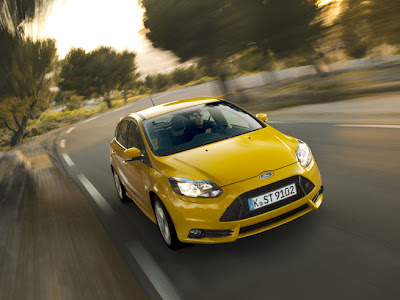
Behind The Wheel
Feels tight and solid in an almost BMW-like way. Tuned for fuel efficiency, the auto is slow to downshift.
Statistics
Engine : 2000cc 4-cylinder 16-valve turbo, 247bhp @ 5500rpm, 250lb ft @ 1750rpm
Transmission : Six-speed manual, front-wheel drive suspension MacPherson
Performance : 6.5sec 0-62mph, 154mph, 39.2mpg, 169g/km
How heavy / made of? 1362kg/steel
2012 ford focus st owners manual includes a really simple. But, you can exploit the best. Here, you will see how minor repairs to cars ford focus st 2012.
Double clutching
Principle of Suspension System
- To restrict road vibrations from being transmitted to the various components of the vehicle
- To protect the passengers from road shocks
- To maintain the stability of the vehicle in pitching and rolling
Sunday, April 7, 2013
Hydraulic Pump 2819 and 2820 HYDRAULIC HAND PUMPS Instruction Manual
Download: Hydraulic Pump 2819 and 2820 HYDRAULIC HAND PUMPS Instruction Manual
FORD ARIES F450 F550 PARTS AND SERVICE MANUAL
Find a suitable road crossing to position the vehicle on rail. If necessary set up cautionary devices to ensure safety. 2. Position the vehicle with the road wheel tires on the rails, and the rail wheel flanges positioned centrally above the railhead. Backing into position is usually easier. 3. Put the vehicle’s transmission into park or neutral. Set the parking brake. 4. Engage the PTO hydraulic pump or start the auxiliary hydraulic power source. 5. The rear will be placed on rail first. a. Raise the rail gear up a bit to relieve the pressure on the lock hook. b. Pull the T-handle for the lock to swing the hook out of the way. c. Lower the rail gear into position on the rail. d. Release the T-handle for the lock. 6. Check the alignment of the front rail wheels with the track – it might be necessary to adjust the position of the vehicle. 7. The front rail gear will now be lowered. a. Raise the rail gear up a bit to relieve the pressure on the pin lock. b. Remove the both pins from the upper holes. c. Lower the rail gear. d. Install the lock pins in the lower holes. 8. Engage the steering lock. 9. Drive the vehicle forward and backward a few yards to check vehicle’s operation and brakes. 10. Vehicle is now ready for rail travel.
Download: FORD ARIES F450-F550 PARTS AND SERVICE MANUAL
Saturday, April 6, 2013
Automotive Service Manual A Valuable Entity For Vehicle Owners
Friday, April 5, 2013
Alfa Romeo 156 Car Test Owner manual
Download: Alfa Romeo 156 Car Test Owner manual
HYUNDAI ACCENT 1 6 litre 3 door hatch
engine capacity has been enlarged from 1.5 litres to 1.6 litres. At the same time, the gear
ratios in both manual and automatic versions have been re-jigged and wheel size has gone
from 13 inch to 14 inch. The power steering assistance has been increased at parking speeds and decreased at highway speeds, and the rear suspension has heavier duty lateral links. A range of measures designed to reduce noise, vibration and harshness have been introduced to improve the Accent’s general driving feel. Equipment upgrades include the addition of a tachometer, a change to an electrically driven speedo and odometer, three adjustable rear seat head restraints (but still only a lap belt in the centre) and separate retractable cupholders in the dash. Interior trim fabrics have also been upgraded.
Download:HYUNDAI ACCENT 1.6 litre 3-door hatch
2003 08 Toyota 4Runner Signal Mirror Installation Manual
Download: 2003-08 Toyota 4Runner Signal Mirror Installation Manual
2007 Propietario Honda Fit Manual
Descarga: Manual de 2007 Propietario Honda Fit
1985 93 Alfa Romeo Spider Service manual Catalog
Introducing a multi-stage, automotive insulation and sound damping system to give older Alfa Romero cars the “quiet riding comfort” found in today’s new cars. AcoustiSHIELD kits are designed on current “state-of-the-art” auto acoustic technology, to insulate and control the noise, vibration and heat in the passenger cabin. Kits are pre-cut and come with easy-to-follow installation instructions- —-everything you need to do the job right.
Download: 1985-93 Alfa Romeo Spider Service manual Catalog
Thursday, April 4, 2013
Installing Stage III HID Headlights
I first have to say that at the time of this article HID4LESSs Stage III HIDs are not out yet. I am the first TT to test them. I was given a great opportunity to test them so I took it.
Lets start off and discuss a few factors that are important regarding HIDs.
1. Projector-lenses are a vital factor for proper HID conversion. Projectors give the xenon light that bluish-white color when viewing them slightly off axis. Audi makes the
best projectors in the industry. This is why so many boy-racers are buying up wrecked Audi headlights. If you have factory projector-lenses your half way there, If not you
can get them from HID4LESS.
2. Quality of xenon bulb. The rule here is if the bulb isnt German (ie. Philips/Sylvania) pass them up. German bulbs have a much higher standard of quality.
3. Quality of Ballast. German ballast are a must. Hella makes a good ballast for stage1 and stage2 (35Watt). Auerswald is the only company (as of now) that makes a stage III 50Watt ballast. Auerswald is a German company that makes ballast for Submarines, Race-cars, etc.. Their Ballast are extremely durable.
4. Color of xenon bulb. Regardless what anyone claims, 4300K Philips bulb is the BRIGHTEST bulb available. It burns a bluish-white color when used with a projector-lens. Pure white without projector-lenses.
6000k Philips Ultinon bulb has a slightly less output and burns a Bluish-purple, with or without projector-lenses. This bulb was designed for cars without projectors. It gives that projector light-show to cars without projectors. Any bulb higher in color temp is not a German bulb and will cause glare and diminished output.
This is Important. True bulb color is achieved after a burn in time of 100 hours. Philip 4300k bulb makes the most change from whitish-blue to a more bluish-white color.
Many people put in a 4300k Philips bulb and are un happy with the color. They dont give the bulb time enough to burn-in to the Bluish-white everyone wants.
There are other factors like bulb placement etc.. but better companies like HID4LESS
takes care of those issues.
Now that I got that out of the way I will explain what HID4LESSs Stage III HIDs are.
Stage III use a 50W Auerswald ballast and a 4300k Philips bulb. (without any decrease in bulb life) The factory HIDs use a 35Watt ballast and a 4300k Philips bulb.
Output of the Stage III is around 5200 Lumens. (Lumens is a true measure of light output) AWESOME! Output of the factory HID is around 3200 Lumens.
This photo shows a pre burn-in comparison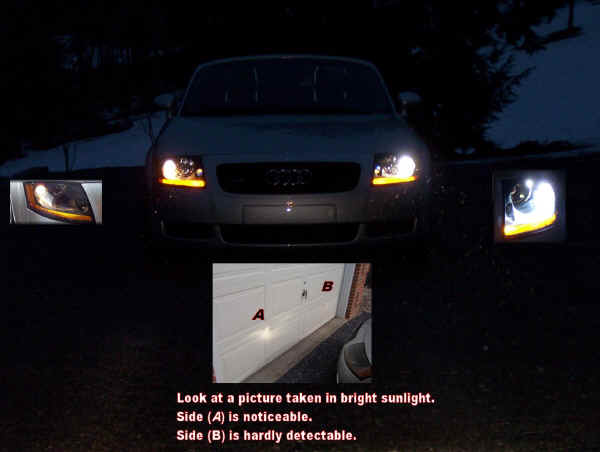
The TT Roadster quattro Twin-Intercooled Turbo is tight to work in but it can be done without taking the bumper off.
Step1. Open hood and take the battery and coolant cover off.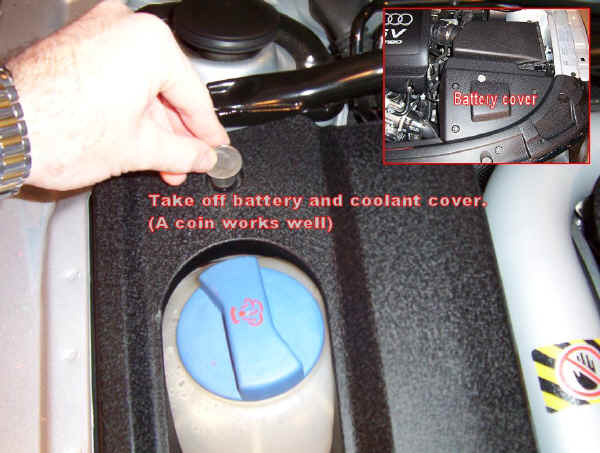
Step 2. Take the dust-covers off by snapping the wire retaining clip off. Remove H1 or H7 bulb by unsnapping bulb-wire clip.
Step 3. Cut larger holes in dust-cover.
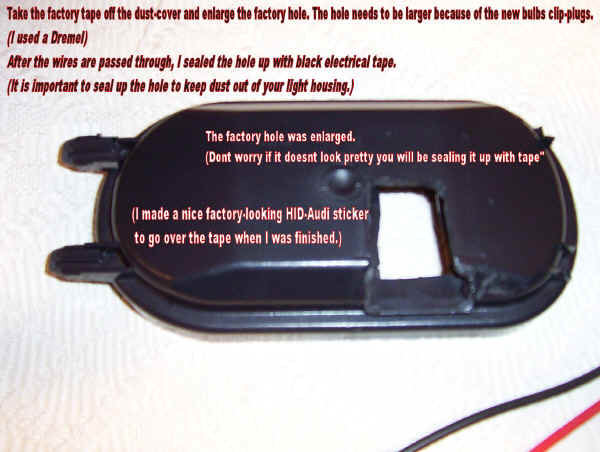
Step 4. Install xenon bulb carefully in light housing. (make sure wire on bulb faces down.) There should be little indents in the base of the bulb that should fit into the factory housing. This insures proper bulb alignment. 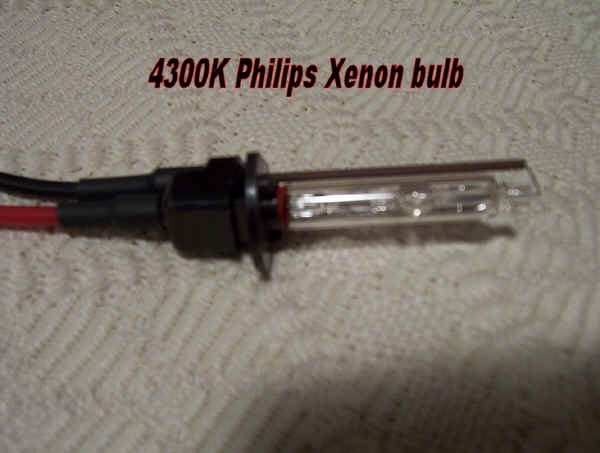
Step 5. Bend bulb retaining wires so the new xenon bulb fits snug. I wont lie to you, this take some effort to bend it just right. I used needle-nose pliers. Have a little patients and dont brake the wire retaining clip. The TT Twin-intercooled motor is real snug under the hood and the driver side light does not give you much room to work. Any other model should be easier.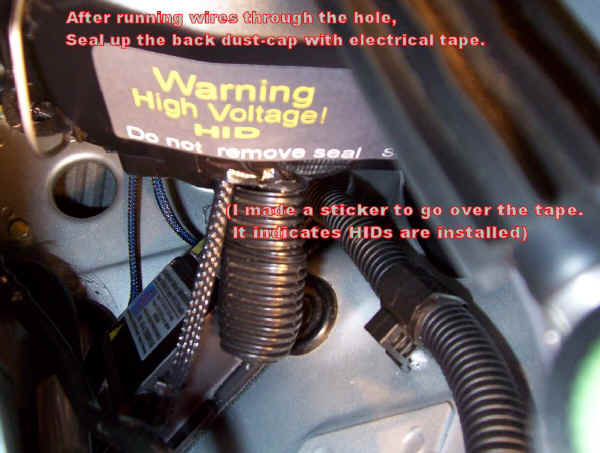
Step 6. mount the ballast and igniter near the light with Velcro. I mounted it on the fender-well.
Step 7. Run your wires through dust-cap and snap bulb and power wires to the new harness. HID4LESS suggest taping all wire-connections with black electrical tape.
Some cars might have to bend the factory female -neg. power supply a bit larger to
accept the new HID male spade.
Step 8. Tape up dust-cap as good as you can and reinstall battery and coolant covers.
Adjust your new STAGE III HIDs.
I found taking photos of the STAGE III HIDs hard to do. Its like taking a picture of the sun.
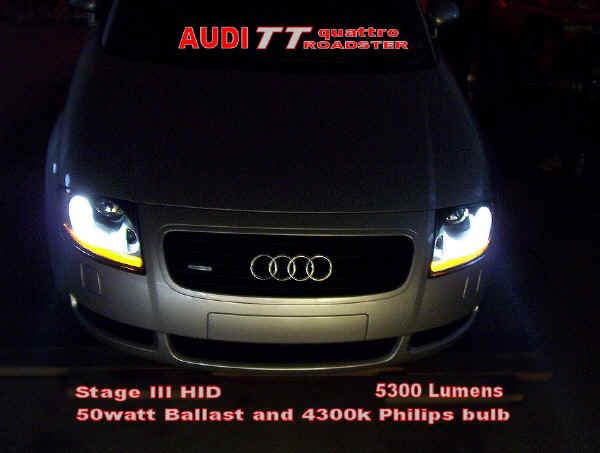
The photos dont do the new STAGE III justice. The are much, much brighter in person.
ALL HID PHOTOS ARE PRE-BURN-IN COLOR
The new output of these lights is much greater than the factory HIDs. The light is crisp and bluish-white. with 4300 Philips bulbs. The draw rate to start the new 50w ballast is only 6.8amps and 3.3amps to run. It does not set off the "bulb out" light either. HID4LESS uses heavy gauge wires. They are the industry leaders in my opinion.
The cost of the new STAGE III isnt yet determined but they are the ultimate HID system.
If your after greatest light output with the factory bluish color. Use the 4300k Philips bulb.
If your looking for a cosmetic look of purple, use the 6000k Philip Ultinon bulb.
This lighting system makes a great impression on the road. Everyone moves out of your way when passing. (and Im sure thats often for most of us!)
Audi TT DIY Proper Use Of An Instant
Ok, you’ve reached that point where your anal about car care. You’ve invested time and money on proper car care products. You’ve spent a day or two, here and there, getting your car looking its best, you’ve polished, and waxed or sealed, now how do you keep it looking like that throughout the week, until your next wash? Not long ago, instant detailers (id’s) came along. Mothers, and Meguiars were two of the first car care companies to introduce it, under names Showtime and Quick Detailer, respectively. These are both good products when used for light cleaning of the vehicles surface. You simply spray on the surface, and wipe clean with a soft cloth…..it can’t be that easy, or can it?
It can be! But with so many instant detailers out there, which one should you choose? You could choose from Meguiars, Mothers, Black Magic, Zymol, Eagle One, etc. These all have their place, somewhere in car care. I guess if I had to pick one of the above, I would go with either Eagle Ones, or Mothers version. They are both very good, and reliable. There are also a few products available online which in my opinion are exceptional products. Clearkote, Poorboys, Adam’s (brand new), are a few.
Lets get to basics with instant detailers, what can and can’t they do?
First off I want to make clear, that these products are not intended to replace normal washing routines. There simply designed to remove light grade contaminants from the vehicles surface, i.e. dust, fingerprints, and an occasional visit from a seagull, when you’re in a pinch (no pun intended). You should always carry at least a 4oz bottle of ID when you’re on the road for these types of emergencies.
ID’s are really great for maintaining that just washed/waxed look. Some can be used on windows (Clearkote Quikshine is even recommended for glass, matter of fact, the only thing you cant use it on is your tires). Some are difficult to get off if over sprayed on windows, so read directions on the back label.
There very easy to use, your basically going to use the same technique you do while drying your car. Spray a light mist on the surface (in shade preferably), wipe with microfiber polishing towel in the same direction as you remove your polishing and wax/sealant products (This will remove contaminants). Turn towel over, and buff to finish (This will create the shine).
Most products will have either a polymer, carnauba, or silicone content which will deter further dirt and or dust from accumulating. Truly a time saver and can really extend the life of sealant or wax currently protecting your car. Most “speed details” only cost from about $.30 to $.75 per job, so a real affordable alternative to the bucket and sponge! Just keep in mind, this is a between washes, product, not intended to replace the bucket and sheepskin wash mitt!
Audi A4 B5 DIY Valve Cover Gasket
First take off your engine cover and coilpack. The coilpacks are held in by a 5mm allen bolt (not sure if they are bolted down on newer motors) Now located the 5 10mm nuts that will need to be removed as well as the grounding wire. Remove these bolts using an untightening pattern similar to that of a lug bolts. Also unclip the 2 clips holding on the timing belt cover (located at the very front of the motor)
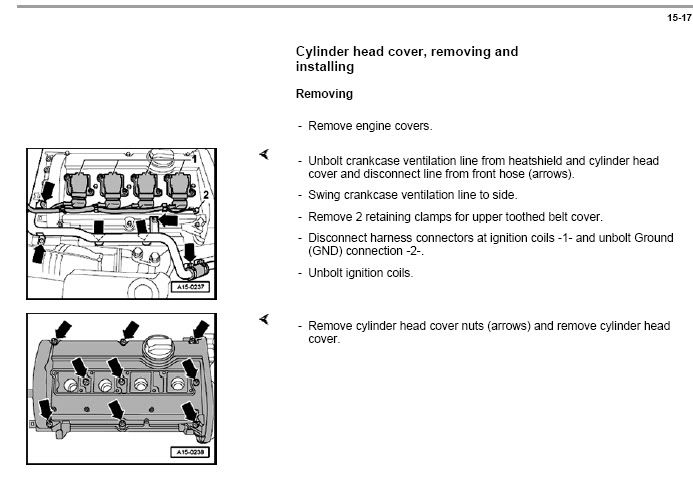

Next pull off the valve cover as well as the gasket making sure not to get any dirt in the motor.
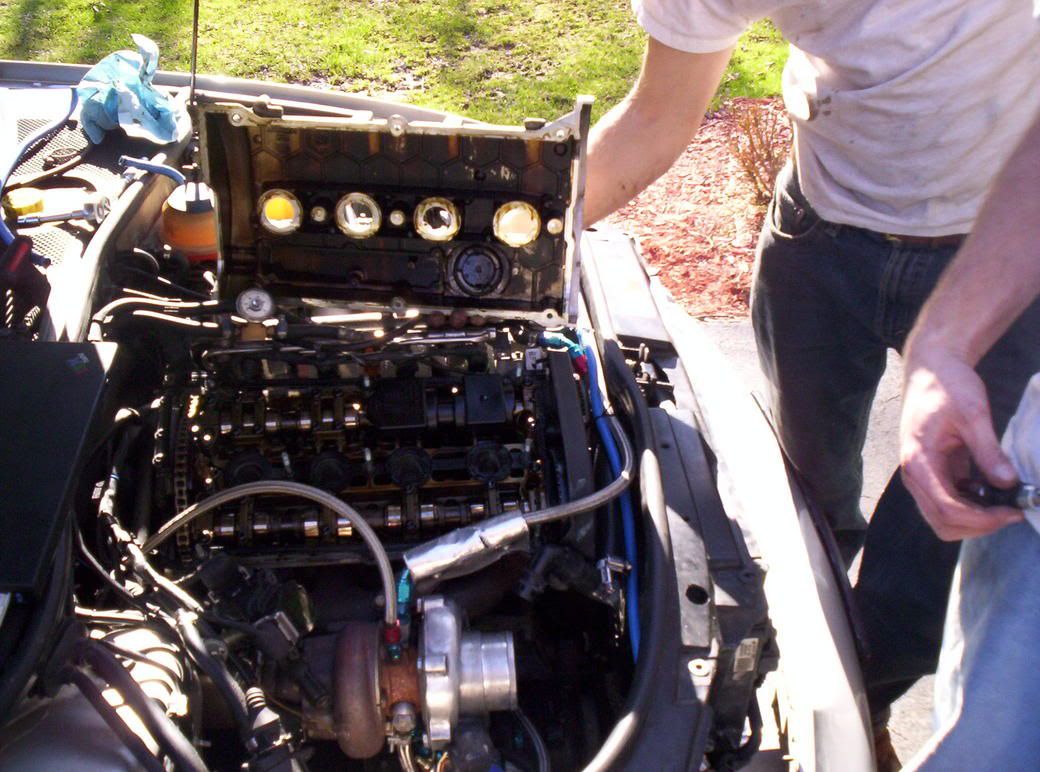
After that clean off the mating surfaces on the head and the valve cover with a clean rag. Dont forget the center 4 holes for the spark plugs as well. After this apply a very light layer of gasket sealer/rtv along both the front and back of the motor especially in the corners and the "v" part of the head. Also apply to the matching side of the valve cover. (In the pic I only have the corners done but do all the way across the front and back of the motor.)
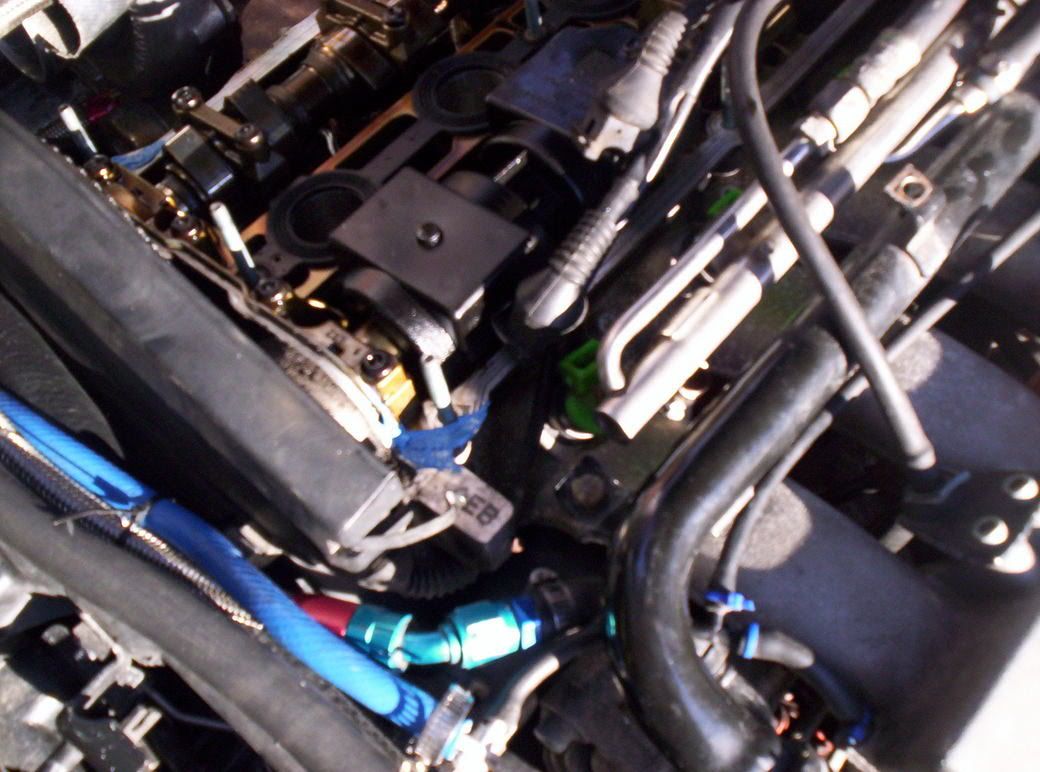
Finally put the gasket and valve cover on and torque the bolts down to 7ft/lbs, using a tightening pattern similar to that of lug bolts.
Mitsubishi Pajero Montero 2000 Workshop Manual
Download: Mitsubishi Pajero / Montero 2000 Workshop Manual
Audi A4 GT28RS Answers
Disclaimer #s I SUCK AT SPELLING AND DONT PROOFREAD
Parts
gt28rs turbo
gt28rs -> v-band adapter
3" test pipe
3" downpipe
upgraded exhaust
exhaust manifold with t25 flange
v-band
exhaust manifold gasket
copper sheet (make your own gaskets, all atps surfaces are not flat)
misc hardware
2 90 degree silicon bends
vr6/2.75" maf housing
misc clamps
3" filter
3" metal pipe
turbo to f hose adapter
440cc injectors
walbro 255lph fuel pump
adjustable fpr
fp gauge
These fittings

oil filter housing to 4an adapter
2 atp cnc banjo bolts and fittings
atp cnc machined oil pan adapter
gasket material (dont use atps)
misc clamps
manual boost controller,
10 of silicone tubing
a couple tee connectors
dv
fmic
clutch (capable of 400+ tq
programming
vag-com
wideband a/f (highly recommended but not necessary)
misc hardware/gaskets, etc
Installation
*Give yourself at least 4 days of downtime. My car took 4 days 18hrs a day to get installed and running, but i didnt buy the atp kit.
**This is not plug and play, and keep in mind you WILL be under the hood every weekend getting things right again.
-First remove old turbo and all related parts, oil/coolant lines, intake pipes, cat, etc
-install new oil lines, the feed is self explanatory 4an hose. The return (10an) needs to have no restriction otherwise your $1g turbo is done, and its not rebuildable! Make you own gasket for both cnc flanges, on the pan and turbo. The bolts for the pan are a major pita to tighten, I had to bend a wrench
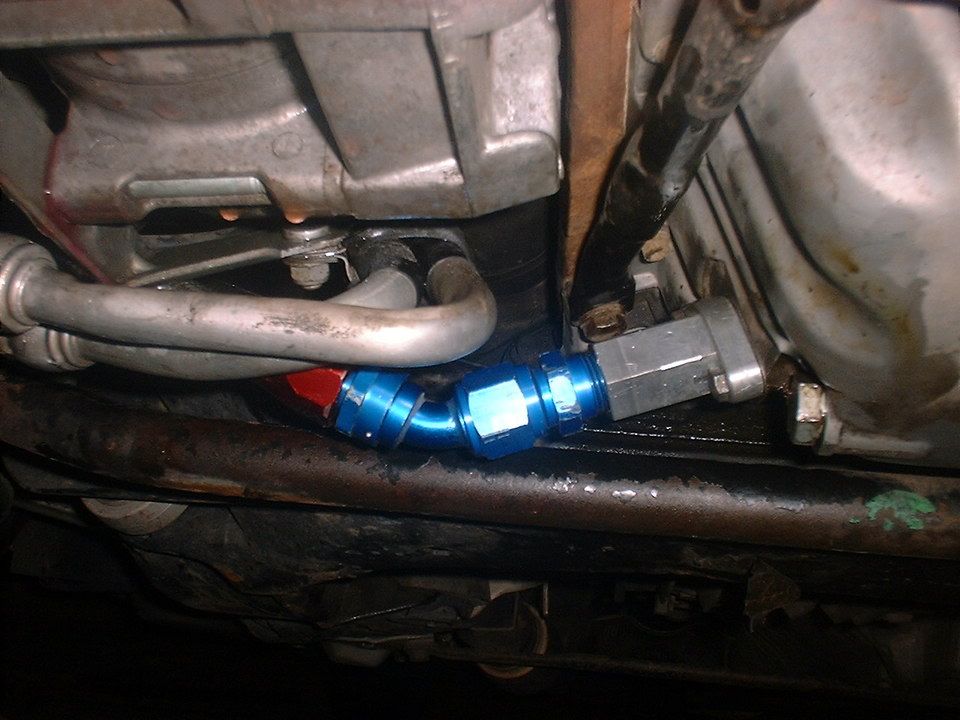

-install the coolant lines. both are 6an and will attach to the turbo via banjo fittings. For the feed, uses the barb fitting and clamp it around a rubber hose which goes to the stock location.
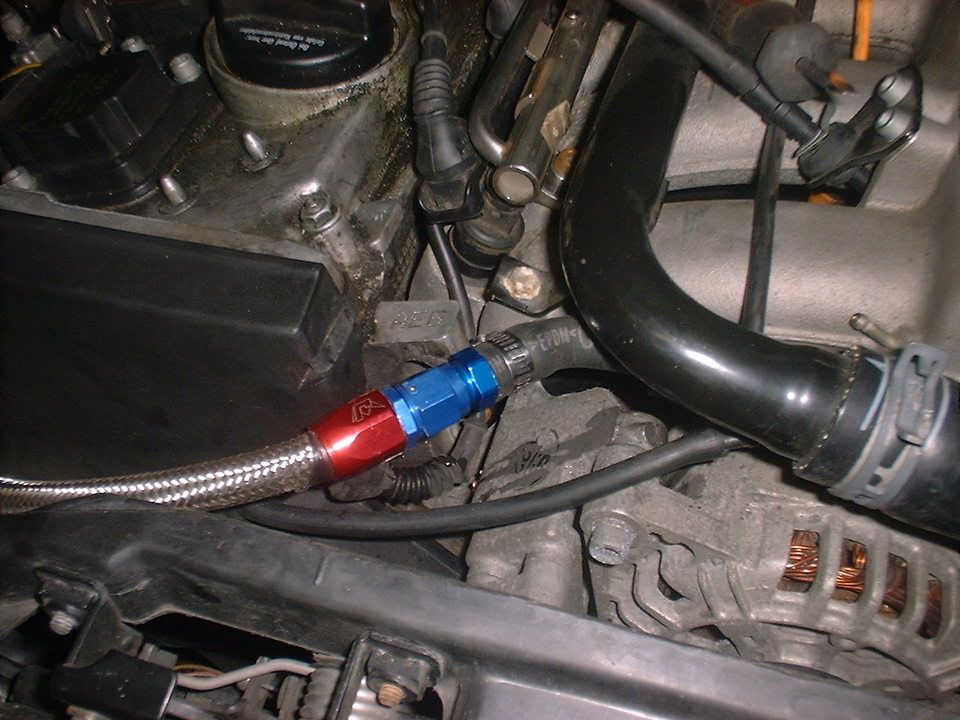
For the coolant return there is a pipe sticking out of the block, clamp the ss hose around this pipe

-Install exhaust manifold. I had a custom one so i had to shave off some of the head, but that shouldnt be necessary with most manifolds. install gasket and wastegate blockoff flange.
-clock turbo, to that comp housing is turned properly, This is done by very carefully looseing the nuts on the comp housing and turning. You will need to extend and twist the wastegate arm. Some people need to make a new wastegate actuator bracket but that wasnt necessary for me. Also adjust the wastegate so that it has 7-8 lbs of preload.
-Bolt turbo to exhaust manifold. Make sure you use a gasket with a fire ring. Tighten all hardware.
-Trace v-band adapter and make gaskets for the both the v-band and the 5 bolt discharge out of copper. Then bolt this up, along with the downpipe.
-Take out the maf element from the stock housing. Dremel the vr6 hosuing so that the stock element fits in. Silicone it in. Extend maf wires about 1 ft.
-Cut a 1" hole in the silicone elbow for the bypass valve return.
-find a way to connect the turbo outlet to the f-hose. I initially used a second f hose cut in half, as well as a 2" pipe with flared ends. now i have custom intercooler pipes.
-Connect the silicone 90 degree bendwith hole clamped to the maf (make sure direction is correct, then 2nd 90 degree bend, then 3" pipe, then air filter which should sit behind the passenger foglight.
-Connect maf wires and bypass valve return
-connect wastegate vac line, and boost controller.
-disconnect the n75 valve vac lines, but leave it plugged in mechanically.
-cut pcv pipe
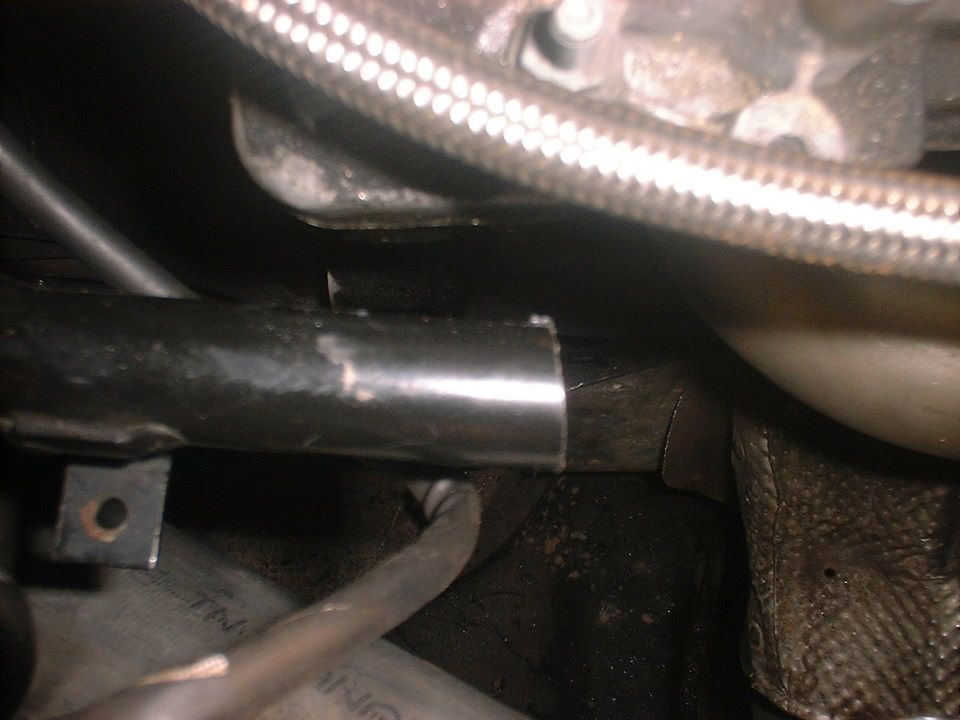
and find a rubber bend so that the oil doesnt drip onto the downpipe or manifold
-install programming
-install injectors, fuel pressure regulator, and fuel pressure gauge. Make sure to uses fuel injection clamps on the gauge install and also make sure its on the fuel feed hose not return.
-install fuel pump, in order to make the walbro mustang pump work in the audi, you will need a piece of rubber hose to keep it tight in the pump holding contraption. Look for john baass install on audiworld.
-clean up tools, get blood off hands, drink beer,
-pull fuel pump fuse and crank over to get oil into the turbo
-install fuel pump fuse andstart up car. It will idle like ****, maybe no idle at all but it will eventually adjust. check for any leaks of anything, and fix where necessary.
*It will smoke for while
- Let it warm up and take it out for a test drive keeping a careful eye on the boost gauge (i pinned my gauge the first time due to improper wastegate preload.
Tuning
Begin by hooking up the vag-com, and start up the car remember to let the fuel pump prime before turning over. The vag is just to make sure you can see whats going on if there is any issues. It will probably idle like crap or not idle at all, but should smooth out after 15 min of driving. In my case it didnt and I spent the next 2 months playing around with maf sizes, fuel pressures, and injectors and not idle at all. I had to keep my foot on the gas the whole time which meant left foot on the clutch and right hand on the ebrake when i had to stop.
Once you get your idle set, more than likely your fuel trims have adjusted. Get out the vag-com and monitor knock sensor voltages, timing correction, o2 sensor values and any codes you may come across. Make adjustments where necessary. Remember if you start pulling alot of timing like over 9 degrees or so, you need to do something about it otherwise the motor will not last long. Also listen for knock (marbles in a tin can) I have never heard it personally but i very rarely listen to my radio now, Im always listening for knock just incase.
Check your codes and do logs very often to keep track of whats going on. fuel trims within 20% are in spec and will not throw a cel, but if possible try to keep them within -+10%. Also remeber -10% is rich, +10% is lean. A bad o2 sensor will cause the fuel trims to either not adapt, or adapt incorrectly causing clouds of black smoke, stained bumper, lots of backfires terrible gas mileage, and other problems...dont ask me how i know. Lets say once you start shooting out fire, ppl tailgaiting will no longer be a problem

Next build a pressure tester. You will be springing boost leaks like crazy...at least i am. The consists of a 2" pvc cap with a bike tire valve epoxied to it. You clamp it around the turbo outlet tube, inflate to 15psi or so and spray all vac lines and charge pipes with soapy water and check for bubbling. You may be surprised what you will find.
Some other little tricks to help with the many strange issues that come up are moving the location of your maf housing. Idealy you want at least 6" of straight tubing on each side of the maf but that not gonna happen with this set-up. Also make sure the bypass valve plumback is not entering to close to the maf otherwise it will disrupt flow, and cause bad readings and crappy idle. Another important maf thing to keep in mind is when ppl say 3" maf they are refering to 3" od which is really closer to a 2.75" id which is what is important..again dont ask how i know.
Driving Impressions
You most likely will not get in the car the first time and drive it and be shocked like most other set-ups, it runs like complete **** for a while, you tune it and gradually get it better and better, until finally you either put up a good time at the track or whoop up on some sti or corvette. Then you realize what you have done, and the grin will not be wiped off your face until the next time you break down which honestly, probably wont take long. (always, always carry extra tools, duct tape, and the sleeping bag that comes in the audi survival package
 , na u shouldnt need the sleeping bag but the other stuff is very important)
, na u shouldnt need the sleeping bag but the other stuff is very important)The car is really alotta fun, at 15psi the thing begins to haul very very quickly and by 20psi its feel unstoppable. Power comes on very smooth from a roll and is much more drivable in the corners than a chipped ko3 or ko4 because there is not a sudden torque spike. Once spooled it feels like it will pull forever. Its pulls on the highway like nothing else and you really really hafta watch your speed. Maybe I should add a valentine 1 to the list of materials needed. If properly tuned it should run mid 12s with an experienced driver (not me), so thats faster in a straight line than many ferrraris, porsches etc.
I know a guy who runs 34psi on this turbo on stock internals "when i need a thrill" He says" image driving down the highway at 30mph, punching it and getting sideways with awd from a 30mph roll." I have never done this in my car but you really do hafta be careful on wet or dusty roads because once boost begins it will occasionally break loose and get a little sideways in 1st or 2nd gear. I also have aproblem with overrevving when stuff like this happens. I have pinned my tach on several occasions. Aparently the atp rev limiter only works under load.
Overall this turbo kit will cause alot of blood sweat money (in my case credit cards, which are finally being paid off), rediculous amounts of time everyweekend, and many times stranded on the side of the road...i havent had to get towed yet but if you dont know your way around the car and how to diagnose stuff add money to the mod fund for tow trucks fees cause stuff will break! As long as you do all the work and everything you will learn alot of this as you go along, but DO YOUR RESEARCH first. What I have listed in this post is not everything you need to know, but just some of the important stuff that i remember off the top of my head.
Oh yea, if you get frustrated, put the keys down, drink a beer go to sleep and try again in the morning, you will be thinking much clearer

Heres a couple vids hopefully for inspiration.
Winter 05: ko4 -> gt28rs
Gt28rs at 16psi with many leaks
Wednesday, April 3, 2013
Mitsubishi Lancer Engine Service Manual
Download: Mitsubishi Lancer Engine Service Manual
2009 BMW 1 Series Owner’s Manual
Download: 2009 BMW 1-Series Owner’s Manual
Audi TT DIY B5 A4 Pre 99 5 BPV DV Install
I changed my BPV / DV (bypass valve / diverter valve) today (710N), so I snapped some pics and thought Id post in case anyone was interested.
I have a 1997, so the BPV is NOT in the same spot as most A4s. Its located higher up, and you really cant get to it from below. So, there is no need to jack up the car for this.
Tools needed:
1. Flathead and Phillips screwdriver.
2. Size 30 Torx socket attachment (for the headlight removal).
3. Small Hands.
Optional:
- Extra Vacuum hose. Size 3.5mm or 5/32".
- Little clamps for vac hose that you replace (can get at www.ecstuning.com). Or just use zip ties.
STEP 1: Remove airbox cover pieces.
Just pop off the plastic covers over the air box (you DO NOT have to remove the airbox, just the covers). The cover pops off, and the flex snorkel too. The little snorkel piece in the front has two screws holding it in.
STEP 2: Remove Headlight.
Theres three torx screws holding in the headlight. First pop out the sidemarker (this if for those with 2-piece). Then youll see the side screw. The other two are right on top of the headlight.
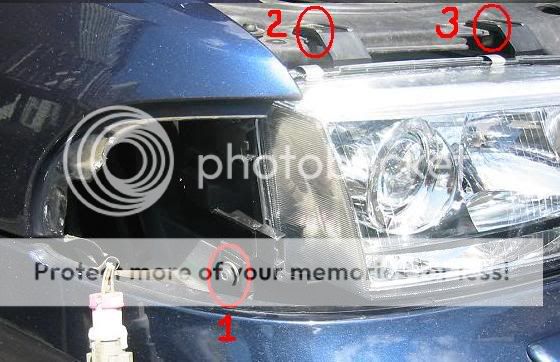
You can then pull out the light, and can easily pop off the wiring connector (just push the little silver clip down, and the plug comes out) then you can completely remove the headlight housing.
Heres what you see when you look in:

STEP 3: Loosen clamps to move the hose from the air box out of the way.

Just loosen the two clamps (number 1 and 2 in the pic) enough to you can move that big flex hose enough to get better access to the BPV clamps. Number 3 is optional if you think it will give you better access. That is the connector to the N75 valve. Theres a silver clip you can push in and pop off that connector. Just be careful with it.
Heres the hoses removed:
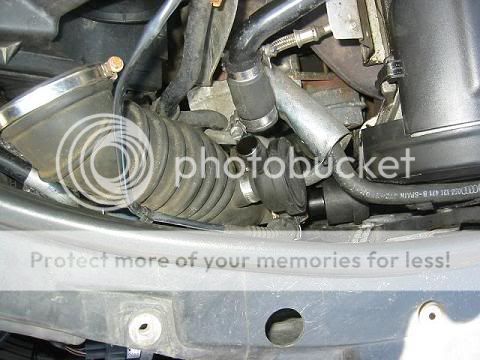
STEP 4: Get to the BPV!
Now when you hold that big hose out of the way, you should able to get a decent view of the BPV (which is behind the fan).
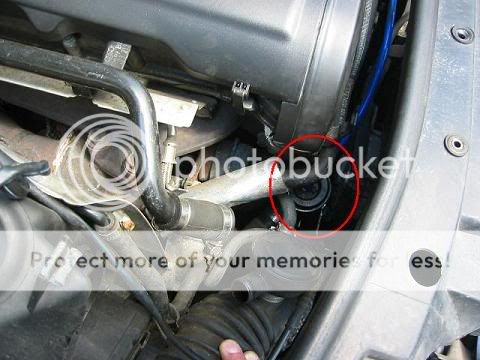
Theres two flathead screw clamps holding the BPV on to each hose attached to it. One of them you cannot get to yet. The first is a bit tricky. I put one arm in through the headlight hole to hold the BPV and clamp at an angle where I could get the screwdriver on it from above. Its a bit frustrating but very do-able. After you loosen it enough, pull that end of the BPV out of that hose. The other end (towards the IC piping) of the BPV is still attached. You should now be able to weasel your way over to that clamp to loosen.
Now the BPV is basically free. The only thing still attached should be the vacuum hose going to the manifold.
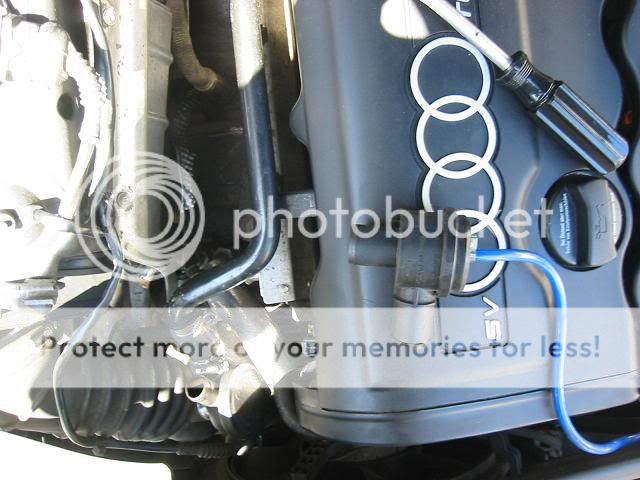
Remove that vac hose. If the hose is old/brittle then you should replace it now. The hose size is 5/32 inches (available at Autozone), its also the same as the 3.5mm ID hose.
Now hook up your new BPV to the vac hose, and put it all back together and check for leaks via your boost gauge. If you dont have a boost gauge, stop modding your car and get one before you bother modding!

search terms: changing BPV bypass valve DV diverter valve 710N 97 how to change BPV write-up install installing installation instructions puting in new BPV
Audi A3 Euro Rubber Floor Mats
Some sort of all-weather mats are an absolute necessity. Carpet mats are magnets for grit, salt stains, etc., and cant be hosed off and put back in right away. I looked at all the options:
- Hexomat, like my cargo liner
- WeatherTech (had them in a previous car, liked them a lot)
- Audi Monster mats, which are similar to the WeatherTech design but have A3 printed on them
- Audi Euro Rubber mats
I ordered them from AutoWebAccessories, which sells genuine accessories at a discount. They were backordered nationwide, but I got mine as soon as they were available in the country. They work great, and I highly recommend them.
One problem was that the snaps were so tight that they could have ripped the fastener out of the carpet. Scraping the inside of the snap on the mat with a knife made them snap on well, but not insanely tight. They give the interior a neat, sporty look. In the photos below they look like they contrast a lot with the carpet, but thats mostly due to the camera flash. In reality, the black mats are very subtle against the black carpet:

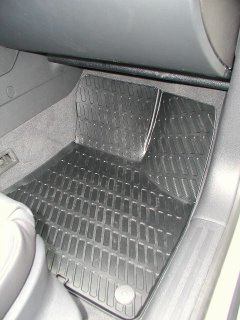

Coding the Control Module for the Audi TT Coupe
The Audi TT comes with several pre-programmed functions in the central locking control module that can be accessed by using the VAG 1551/1552/5051 tools (available to Audi dealers), or PC emulation programs such as the old VWTool, Baums VDS-PRO, or Vag-Com from Ross-Tech. These tools can be used to check your cars diagnostic codes, but they also allow you to make certain modifications to the default programming.
Listed below are several of the codes that will modify the central locking control module in the Audi A4 to access some of the hidden features available on these cars. Please note that Audi of America does not officially recognize that these codes exist and some dealers are unwilling to make modifications to the factory control module coding. You assume all responsiblity and liability associated with these modifications.
To make modifications to the factory settings, numbers are added to and subtracted from the default setting code numbers. Below is a table thatb lists several of these functions and the programming required to access these functions. The value is the number added to or taken away from the default programming.
Please note that these codes are for cars in the North American market.
| Function | Value |
| Add Window Up/Sunroof close, and Window Down with remote.* | +64 |
| Add 1 touch unlock of both doors | -04 |
| Remove horn honk when arming | -1024 |
| Auto lock/unlock of doors (Doors lock at 15 mph and unlock when key is removed) | +32 |
The coding depends on which radio is installed in your car from the factory. The table below shows the total coding value for certain functionality packages that I have experimented with.
| Functions | Coding with Concert Radio |
| (Factory Default)Safety Central Locking**Horn sounds when armingLights flash when arming | 15884 |
| Window control with remote1 touch unlock of both doorsNo horn sound when armingLights flash when arming | 14920 |
| Window control with remote1 touch unlock of both doorsHorn sounds when armingLights flash when arming | 15948 |
| Window control with remoteSafety Central Locking**Horn sounds when armingLights flash when arming | 15952 |
| Window control with remoteSafety Central Locking**No horn when armingLights flash when arming | 14924 |
| Window control with remote1 touch unlock of both doorsNo horn sound when armingLights flash when armingAutomatic door lock/unlock | 14952 |
| Window control with remote1 touch unlock of both doorsHorn sounds when armingLights flash when armingAutomatic door lock/unlock | 15976 |
| Window control with remoteSafety Central Locking**Horn sounds when armingLights flash when armingAutomatic door lock/unlock | 15980 |
| Window control with remoteSafety Central Locking**No horn when armingLights flash when armingAutomatic door lock/unlock | 14956 |
**Safety Central Locking - 1 press of unlock opens drivers door, 2nd press opens passenger door.
Coding Instructions (emulation software)
1. Plug your your computer with emulation software loaded into the Data Link Connector (OBDII port) in your car. This Data Link Connector is located on the drivers side, below the dash, close to the door. Start software. You should see a list of the different modules available.

2. Select your control module that you want to recode. In this case, its the Central Locking control module. In a direct entry address system (VAG1551/1552) enter address word 35 (Central Locking).
3. Your screen should show the current coding of your control module listed as Software Coding.

4. You want to Recode the control module. You dont need to Login to do this. Select Recode.
5. Enter the coding that you want from the above list, depending on the features you desire, make sure your numbers are correct, select Do It or press enter.

6. Your new features should be available immediately.
Coding Instructions (VAG 1551/1552)
1. Plug your your VAG tool into the Data Link Connector (OBDII port) in your car.
2. Rapid data transfer. Insert address word XX should be displayed. Press buttons 3 and 5 to insert Central Locking address word 35. Press Q button to confirm the input.
3. Rapid data transfer. Select function XX should be displayed. Press buttons 0 and 7 to select Code Control Module function 07. Press Q to confirm the input.
4. Code Control Module. Enter code number XXXXX (0-32000) should be displayed. Enter control module coding number from above table using the keypad. Press Q to confirm the input.
5. Display will show control module identification and that the coding has been entered. Press the arrow button.
6. Rapid data transfer. Select function XX should be displayed. Press buttons 0 and 6 to select End Output function 06. Press Q to confirm the input.
7. Disconnect your VAG tool from the Data Link Connector.
Please note: Beware when attempting to code a 98 or newer VW/Audi with an aftermarket radio. The adapter harness that is supplied by the aftermarket ties the "K" line to VBatt. Any service tool or computer that is used on the vehicle may be damaged unless it has been properly fused.
Since these items are not coded from the factory to be readily accessible, and Audi of America does not officially recognize these modified codes, you assume all the risks involved with re-coding your central locking control module. Audi TSB 98-07, which can be found at tech.vw.com covers some changes to the central locking control module that Audi of America does recognize. Please be aware that dealers may charge you for this service, or they may not be willing to perform this service. Some dealers may be unfamiliar with the fact that you can re-code the central locking control module, or they may re-code the central locking control module to factory settings. It would be a good idea to keep a copy of this document with the car in case any questions arise.
When forwarding and making copies of this document, please keep it intact.
Tuesday, April 2, 2013
2011 Audi A3 Owners Manual brochures
Download: 2011 Audi A3 Owners Manual brochures
2010 Subaru Foresterd Owner Manual
Before you operate your vehicle, carefully read this manual. To protect yourself and extend the service life of your vehicle, follow the instructions in this manual. Failure to observe these instructions may result in serious injury and damage to your vehicle.
Table of content 2010 Subaru Forester Owners Manual
- Seat, seatbelt and SRS airbags
- Keys and doors
- Instruments and controls
- Climate control
- Audio
- Interior equipment
- Starting and operating
- Driving tips
- In case of emergency
- Appearance care
- Maintenance and service
- Specifications
- Consumer information and Reporting safety defects
- Index
Audi A3 Nav RNS E and Bluetooth Retrofit single DIN to double DIN conversion
Anyway, I figured that since I was already doing that upgrade, I might as well throw in the OEM Bluetooth module and kill two birds with one stone (as the saying goes...).
It always bothered me that I hadnt ordered these two options straight from the factory. So, I took it upon myself to ease my irritation 
My camera ended up dying after taking snaps of the parts, so I didnt want to wait until it was charged to do the installation. So, the pics are of the parts, and finished results. I will describe in detail how to do the full install.
1) Full list of needed parts - pictures and part numbers:
NOTE: THESE ARE THE ONLY PARTS YOU NEED - dont waste you $ getting other parts that have been posted as necessary:
a) Radio removal keys
- I got these from eBay - $10 including shipping.
b) Double-DIN cage
PART NO: 8P0 858 005 A
CAN $95.00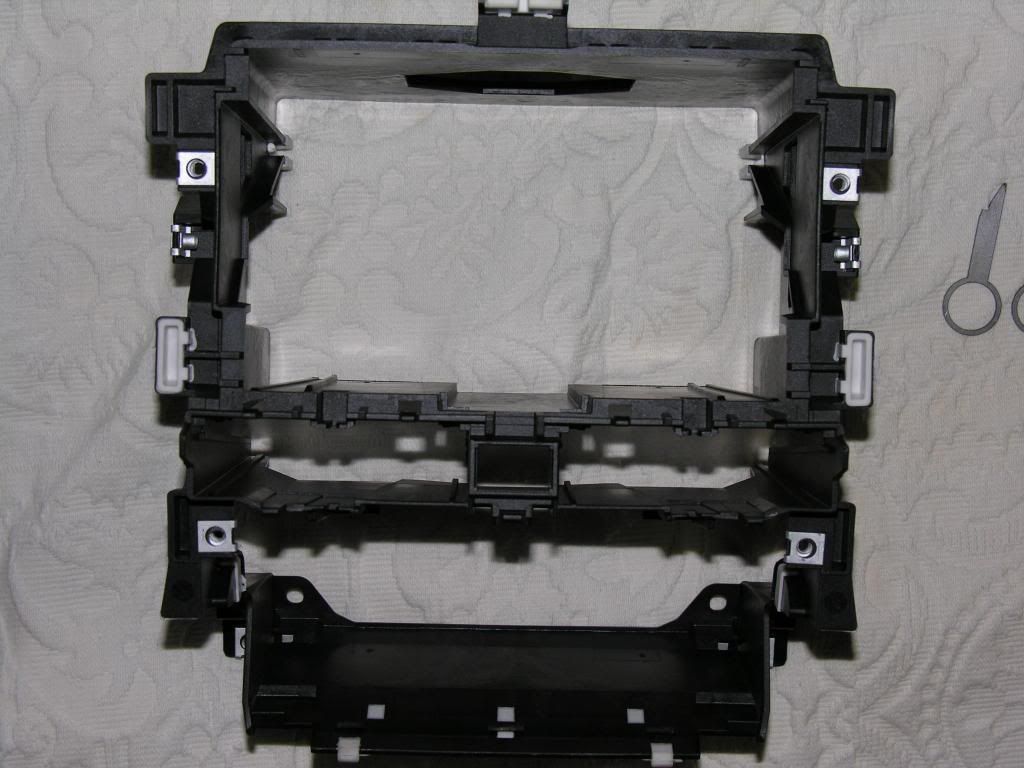
c) Blanks (non-functional buttons)
PART NOS:
LEFT: 8P0 941 515 C 5PR
RIGHT: 8P0 941 516 C 5PR
CAN $10.73 each
ESP Switch:
PART NO: 8P0 927 134 C 5PR
CAN$ 35.00
*YOU DO NOT NEED A NEW HAZARD LIGHT SWITCH - Single-DIN Hazard light fits the same, even though part number is different*
** NONE OF THE OTHER BUTTONS WILL WORK - Single-DIN button, including ESP switch, are all larger**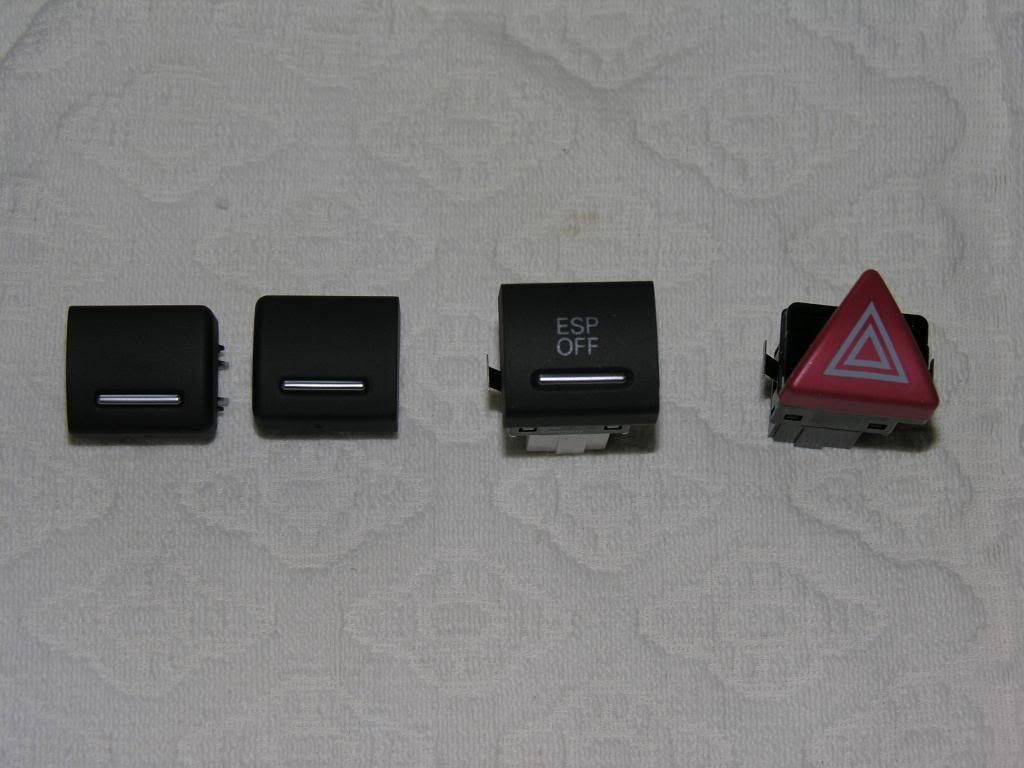
d) Card Shelf:
PART NO: 8P0 941 561 E 5PR
CAN $85.00 (What a joke...  )
)
*AGAIN, Single-DIN card shelf is too big for the double-DIN cage* (sorry for the crappy pic)
(sorry for the crappy pic)
e) Center trim (Goes around switches - again, double-DIN specific):
PART NO: 8P0 863 321 C 6PS
CAN $52.65
e1) THIS IS FOR US CARS ONLY:
Passenger Airbag Warning Light for double-DIN
PART NO: 8P0 919 234 A 5PR
e2) FOR THOSE WITH TPMS OR WANTING TO RETROFIT TPMS:
TPMS switch for double-DIN
PART NO: 8P0 927 121 A 5PR
f) RNS-E Unit
PART NO: 8P0 035 192
**NEW UNITS HAVE A LETTER AT THE END OF THE PART NO: B, C, F, and G**
Bought off eBay for US$900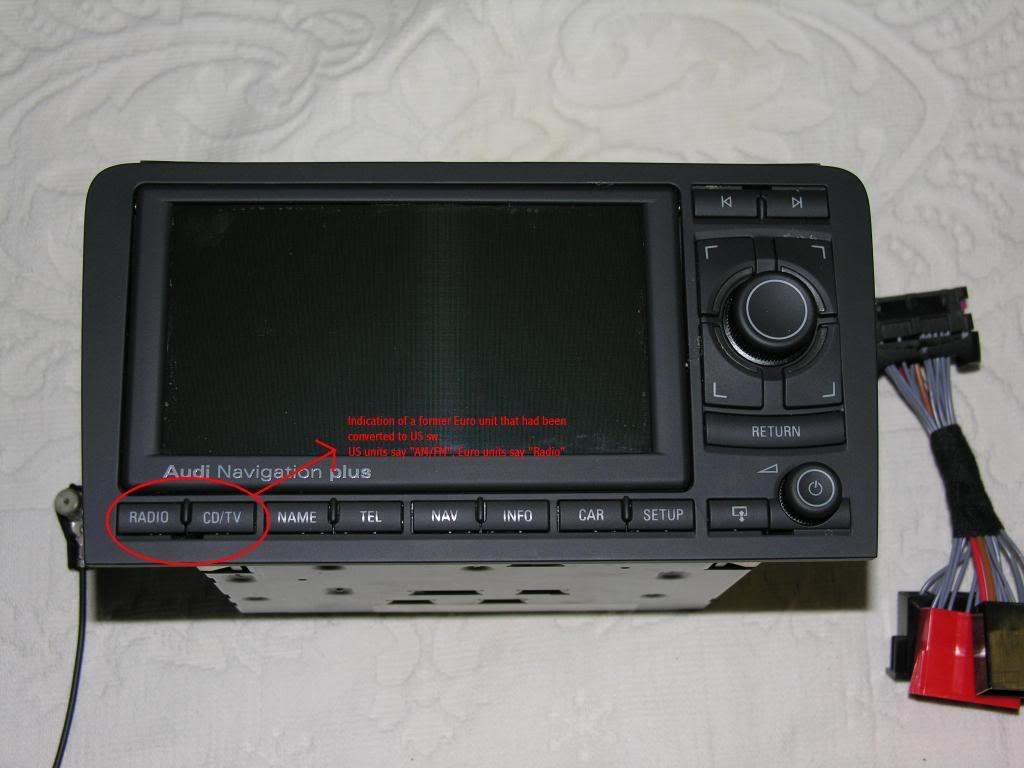
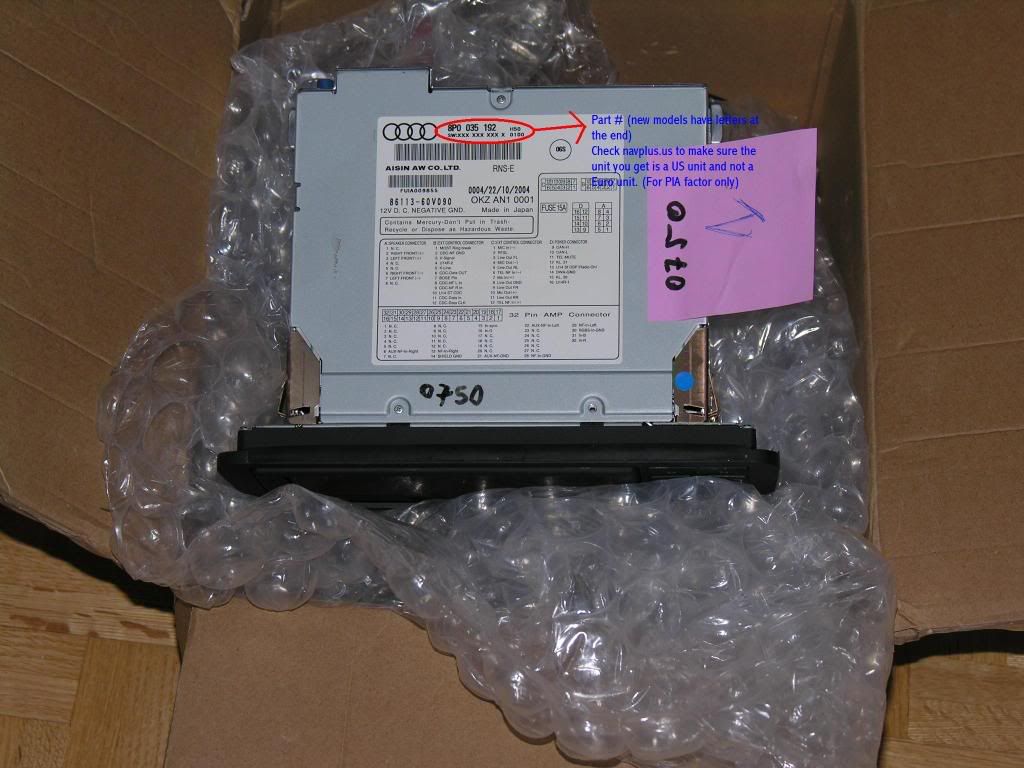
g) RNS-E wiring harness - make sure to get the adapter to work with non-BOSE, w/out telephone (if no BT), w/ CD Changer
**Use this harness only if youre not retrofitting the Bluetooth module at the same time - that requires a different harness**
Can be had on eBay, or NavParts.com or Euro-Parts.us. RNS-E sellers should include this harness though.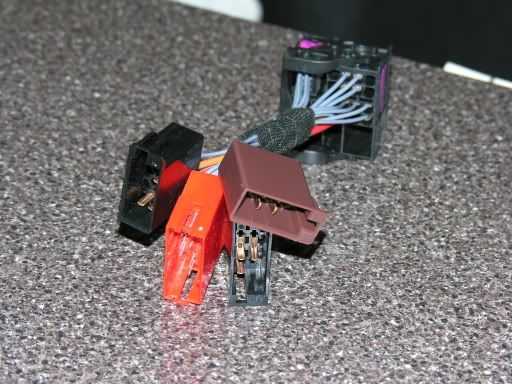
h) GPS antenna and Radio antenna adapter
*These parts should also be included in your RNS-E purchase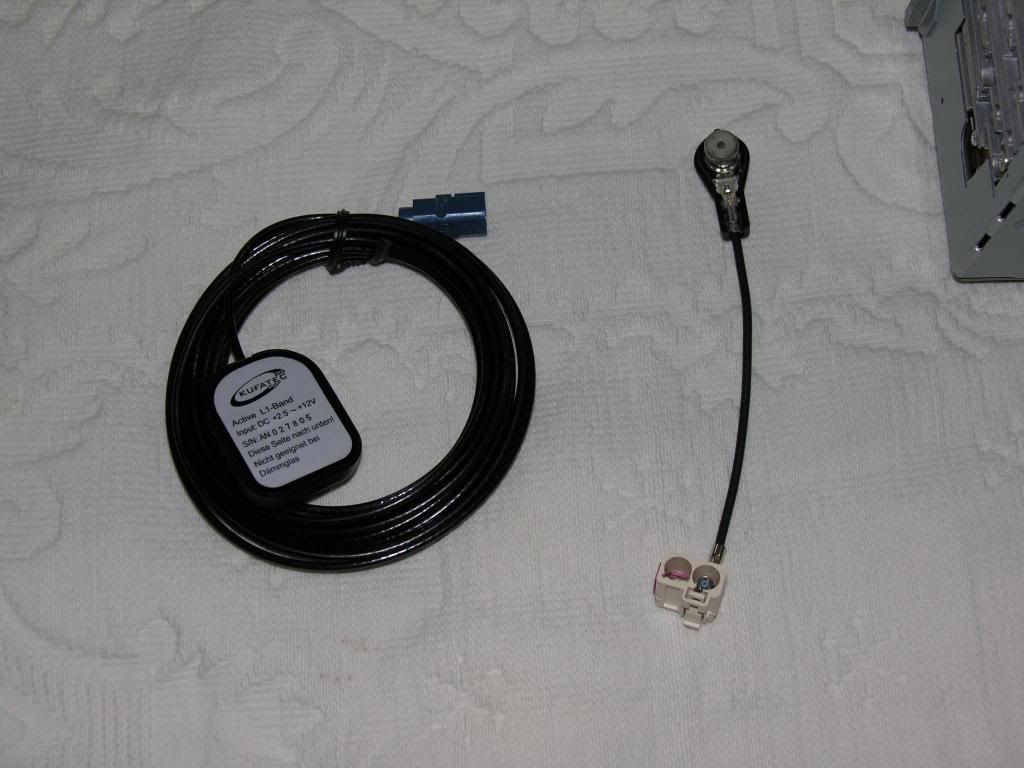
i) Other needed things:
Painters tape (for protection)
Double-sided tape (optional)
Dremel +
flexible add-on (optional)
Soft cloth polishing dremel tool
Cutting tool
Tool kit - Hex nuts, torx bits, strong hands!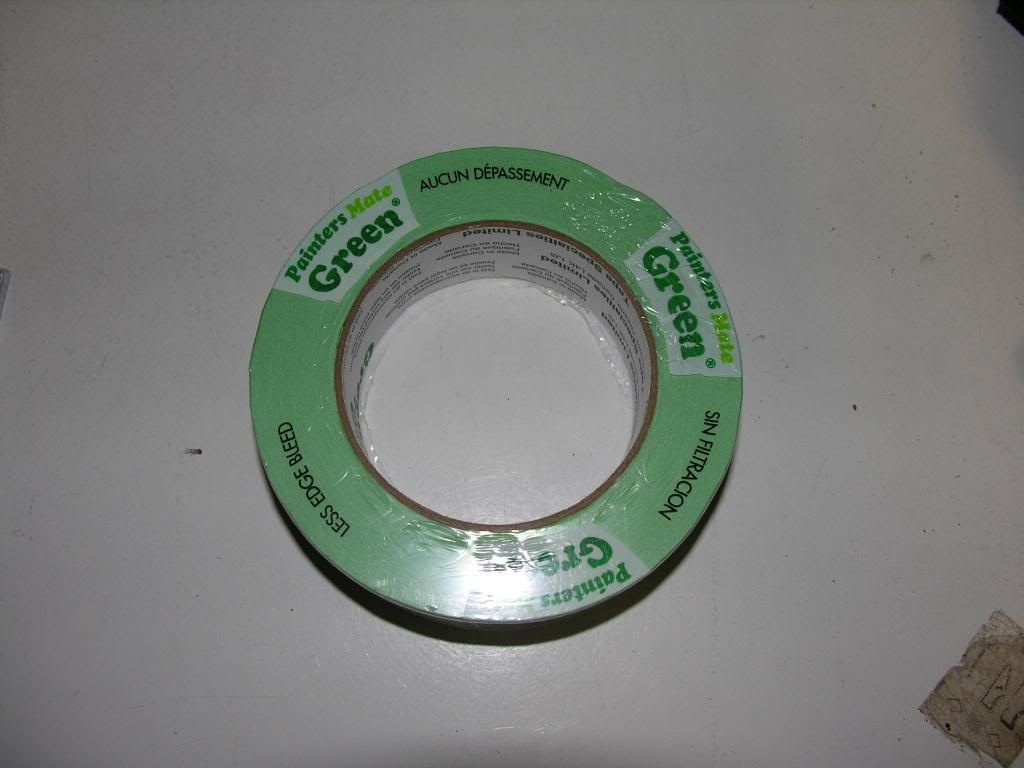

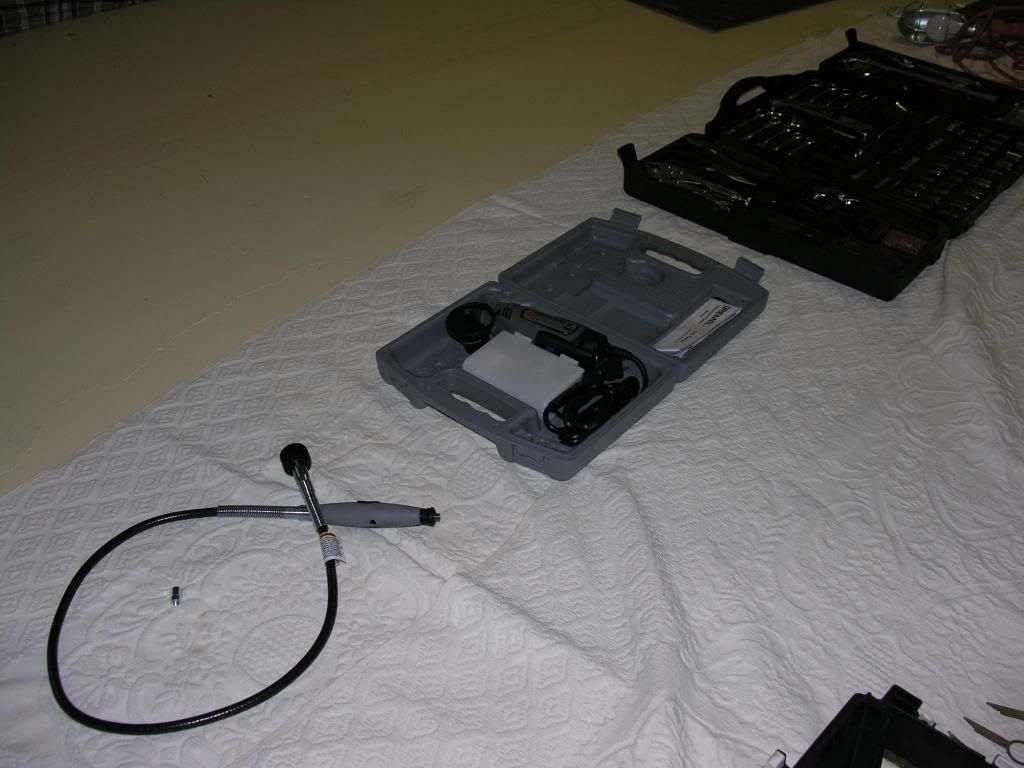
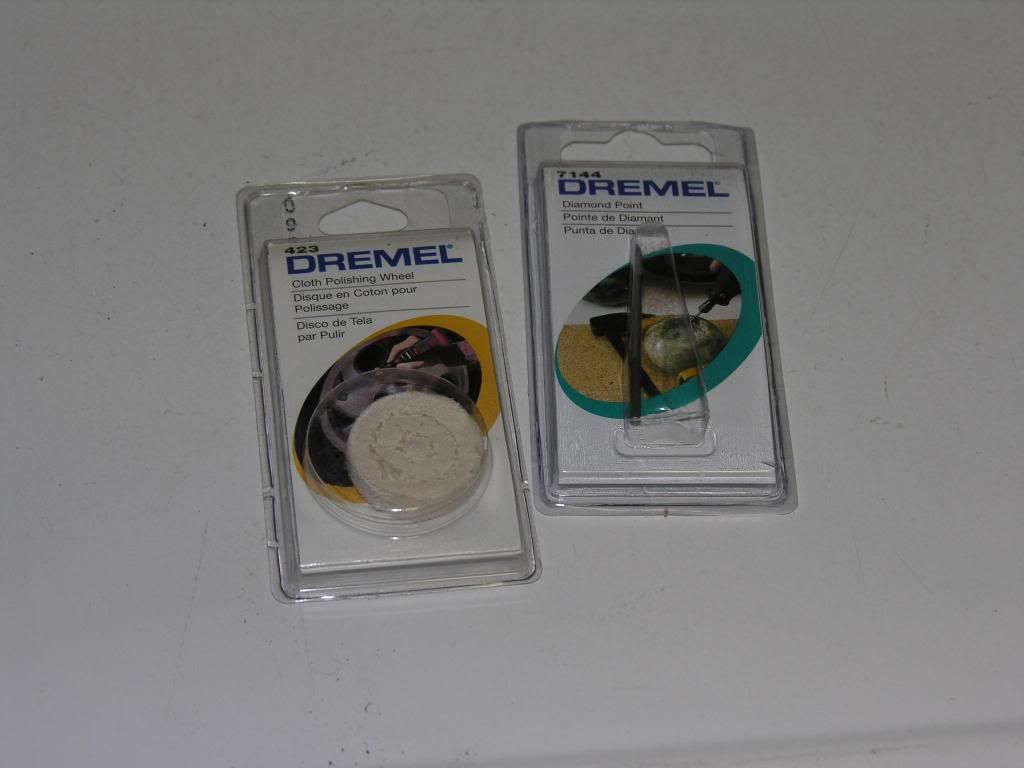
Bluetooth Parts - optional (not needed for RNS-E install)
*I purchased all these parts from Lee at NSX JR. Hes a great guy, helped me out with everything from the install to coding both my RNS-E and BT unit with VagCom
a) Bluetooth Module; RNS-E wiring harness (with mic and BT wires already built in)
b) BT antenna; BT mic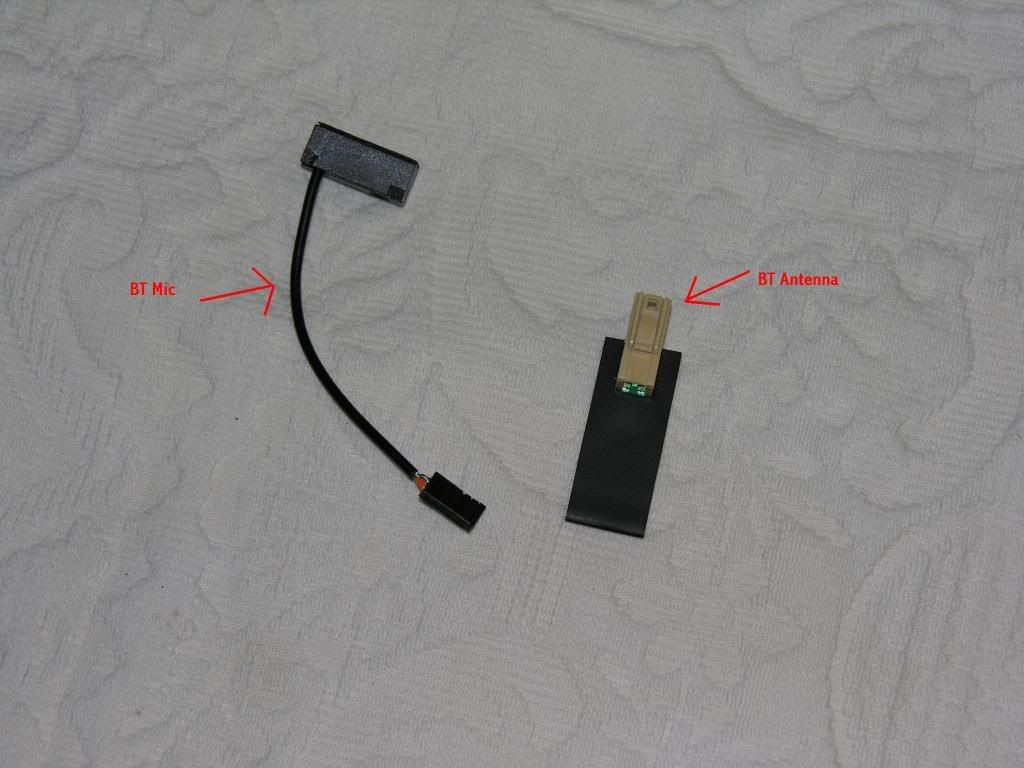
Now, if you have all these parts in hand, youre ready for the install.
INSTALLATION:
Unfortunately, like I said, I dont have pics from the install itself. Its just a matter of unscrewing and removal and replacing.
If youre worried about scratching up your dash, put a towel across your handles, and use painters tape on the outer trim of the centre console.
I didnt do either since I was exceedingly careful... but use your own judgement.
1) Remove Concert II radio
Using 2 radio removal keys, remove the old radio.
*Insert the keys with the hooks facing inward* Once the keys pop in, you cant remove them until the radio is out.
Once removed, disconnect the adapters. Dont worry about not knowing what goes where after - its a simple puzzle. They are colour coded and are size dependant as well.
2) Once the radio is removed, pull off the upper trim piece. Itll pop out easily.
3) Remove blank switches, ESP switch, Hazard ligh switch, and Card holder.
The blanks pop out easily.
The ESP and Hazard switches need to be pulled out and unplugged - again dont worry about confusing them later - colour coded white and black.
The Card holder requires a fine tool to push down on small clips on the upper right and left side. (Easily seen with the drawer open).
4) Remove the climate control unit.
Itll pull out easily with the rest gone. Unhook all the cables - again colour coded and size dependant for later.
Now it gets fun.
5) Removal of ash tray.
Open the ashtray. Hook your fingers underneath where the ashtray meets the shift boot. Lift up firmly. The shift boot trim should pop up. There are two clips in the front and two in the back. Pull the boot up all the way over the gear shift (for 6MT) and put the car in 4th or 6th to get the stick out of the way.
6) Remove glove box and cover underneath steering wheel.
This is a simple process of removing bolts. There are many.
Under steering wheel:
a) Push light switch in, and twist to the right. It should pop out. Disconnect the two connections, and put switch away for later.
b) Remove fuse box panel cover.
c) Unscrew all the bolts underneath the fuse panel. Its obvious which ones are holding the lower dash on.
d) There are two bolts in the foot well. One on the right and one on the left. Unscrew both of those and the lower dash should come off.
e) The top will tilt down. With the top part down, pull outward and the rest of it should come off.
Glove Box:
a) Remove side panel
b) Open glove box and remove everything.
c) Unscrew all bolts - 3 or 4 on side by panel, another 6 or so found after opening the glove box.
d) After all the bolts are removed, the glove box will fall downward. Unhook the pass. airbag connection, the CD changer cable, and the in-box light cable.
7) Remove center console handles.
In the picture below, see the four circles in the shift boot area. Those need to be undone.
On the underside of the handles, in the middle, is a hole reaching to a HEX bolt. From memory, I think it was an 8mm bolt (could be 6mm...). Those two bolts need to be undone.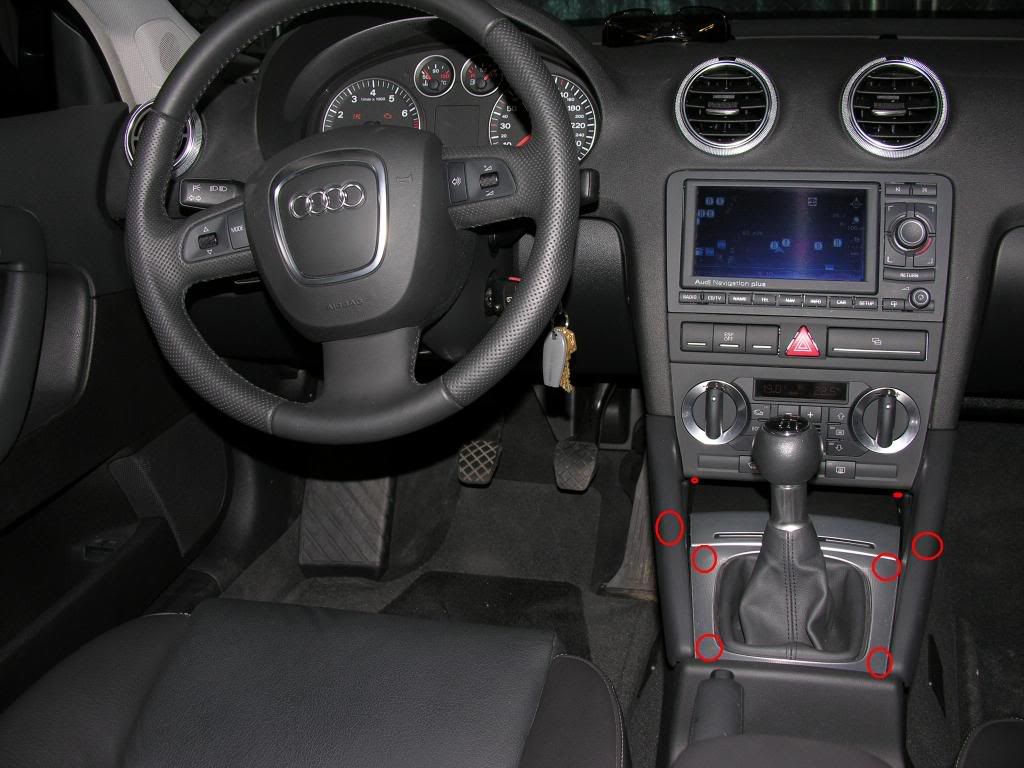
8) Unscrew the single-DIN cage
Where the red circles are, are torx screws. Unscrew all of them and another two screws on the side (glove box and driver foot well lower dash) and this should completely loosen the single-DIN. Loosening all these screws will also allow the handle bars to completely come off.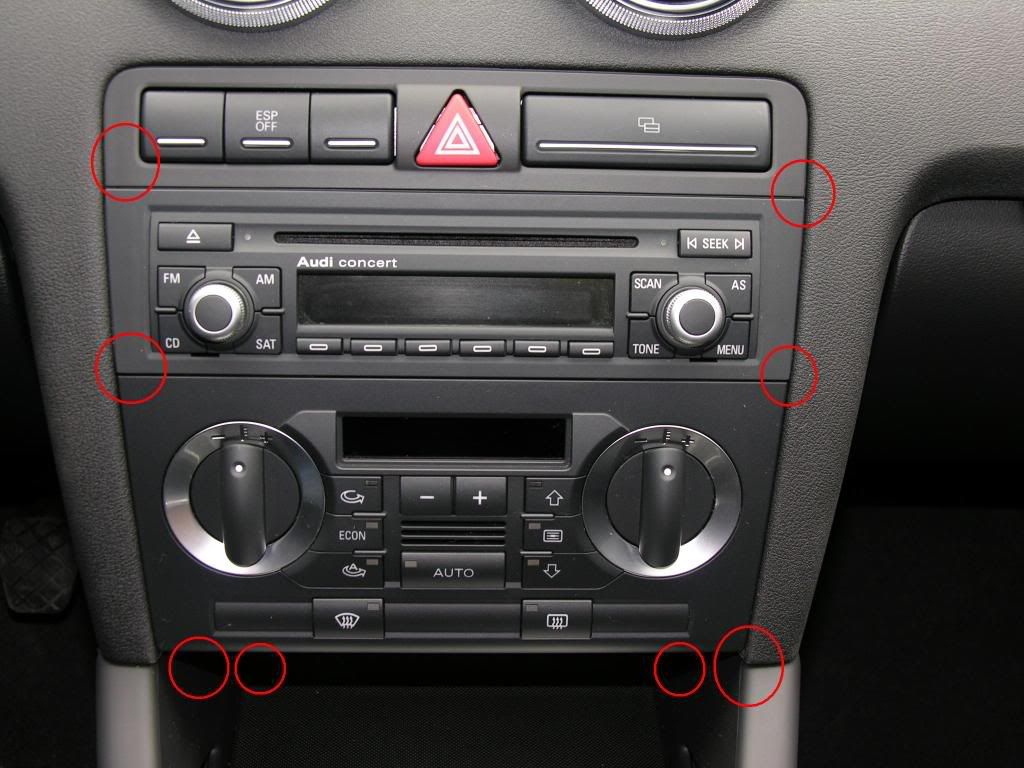
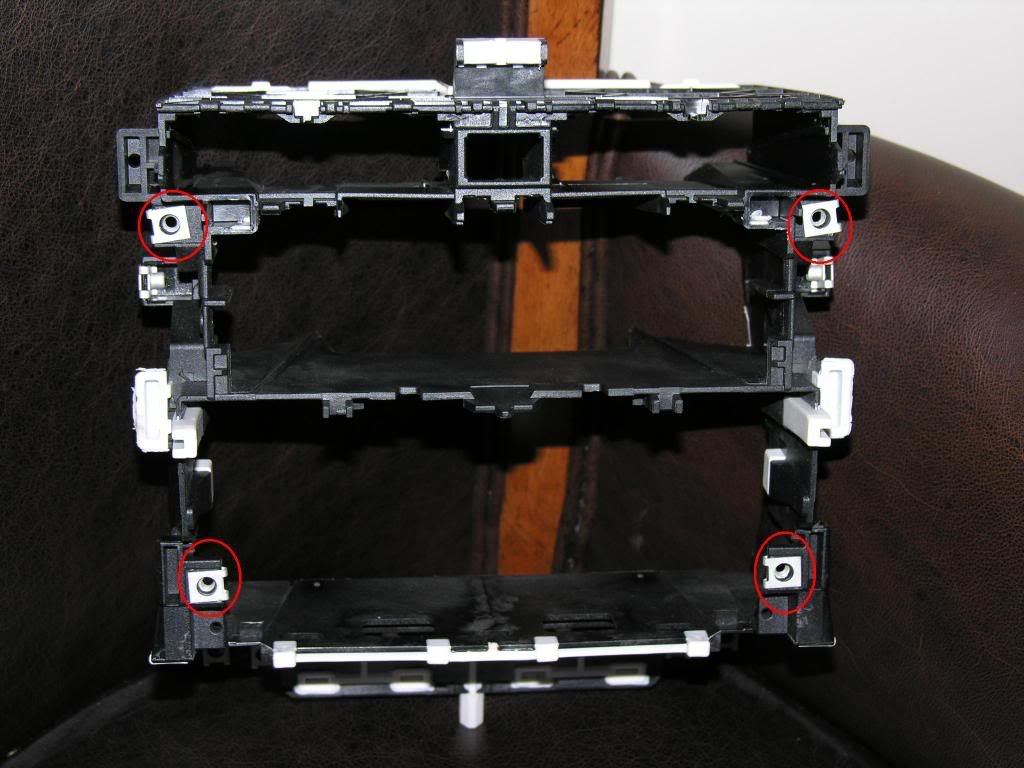
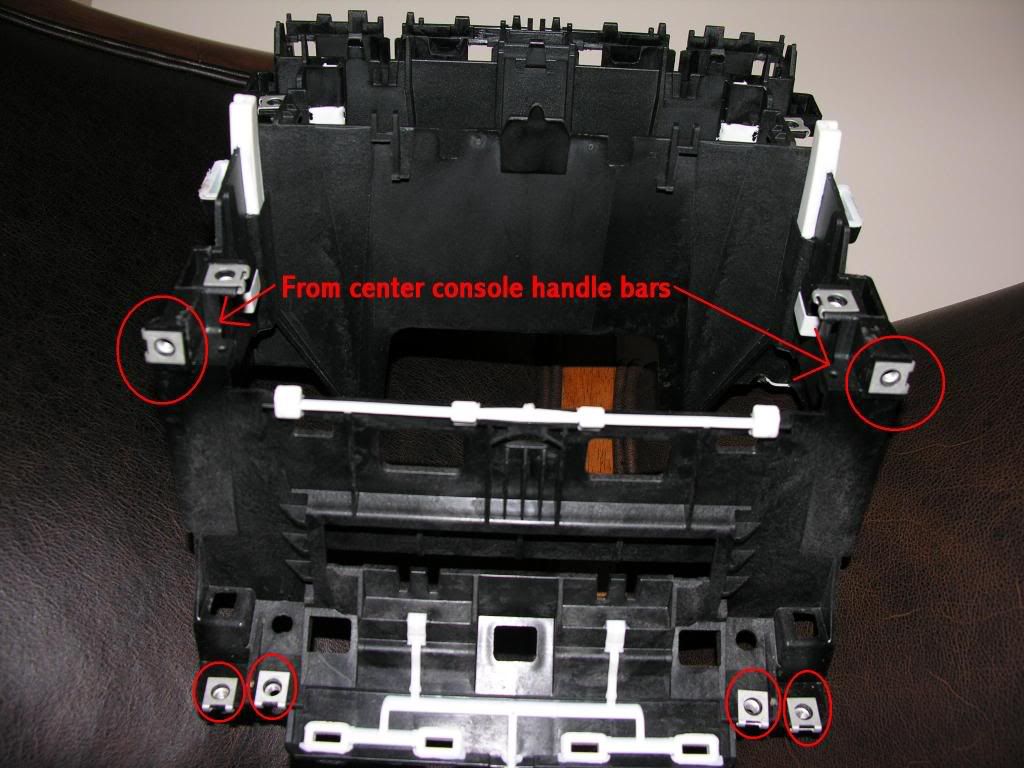
9) Remove the single-DIN cage
This sounds easier than it is. Its not meant to come out this way, but it will come. Pull out and twist down to the right. That worked for me.
**At this point, I had everything out. The ashtray and the "storage" area behind it were out. The entire dash had been taken out.**
Alright, very nice. The removing aspect of the job is done.... now its time for the good stuff. Installing.
10) Install the double-DIN cage
Again, sounds easier than it is. Just keep working it, and it will eventually go in. This is the part when I started sweating - taping the area would have been a great idea, but I managed not to scratch anything.
11) Line up the RNS-E unit in the cage.
Once the double-DIN cage is in, screw in the torx screws, but dont tighten.
12) Slide in the RNS-E unit, but not all the way in. Dont re-attach the cables.
This is check to make sure that the Nav+ will sit straight. If its straight, remove the RNS-E and then go hard with the torx screws.
13) Once all the torx screws have been tightened, install the RNS-E unit.
Attach the new cable harness, GPS antenna, Radio antenna, and push the unit all the way until it clicks.
14) Install the blanks, the two switches, and the new card tray.
15) Install the trim surround.
Now the sensitive part... cutting the climate control unit.
I didnt feel like shelling out $1,000 to buy a double-DIN climate control. So, I used a Dremel to shave down the sides so that it would fit.
16) Make a template of the shape of the new climate control.
I took a piece of cardboard and kept cutting it until it fit into the climate control area (on the bottom) like the actual unit would.
Once I had the exact shape, I centered it on my climate control and cut two rectangles for the knobs.
With the template centered on the climate unit, I traced the outline on it as the marks for cutting.
17) Using a dremel, shave down the sides of the climate control unit.
Take your time with this... keep shaving and testing, shaving and testing.
18) Once the fit is perfect, using a soft cloth polisher, buff the sides of the unit so that its smooth and not jagged from the sanding.
Hardest part is over!
19) Attach all the cables to climate control unit.
20) Wire your GPS antenna to a good location. I wired mine to the driver side fuse box. I get 4-8 satellites there all the time.
A lot of people have wired their antennas up in the instrument cluster.
Its magnetic so itll attach just about anywhere.
If youre really bold, you can get a FAKRA extension and wire it up to the existing sharkfin antenna on the roof... totally not necessary though.
21) Do not turn on car yet! If this is the end of the install, make sure you reinstall all the cables - light switch, pass. airbag, cd changer etc. or youll get a bunch of vag-com codes.
22) Put everything back together. Power on car. Hopefully everything should work - normal satellite reception is > 3.
23) For the ashtray area, I ended up doing a little bit of crude modifying. Since the double-DIN sits so much lower than the single-DIN, the storage area behind the ashtray is essentially eliminated. I didnt want to get a new bezel and trim that would be stuck in a hole Id never see.
After removing the existing storage area trim, youll see four tabs at the back. The two in the middle dont line up with the double-DIN.
I snapped them off.
The result... the same flooring of the storage area behind the ashtray, and more $$ in my pocket.
24) ADMIRE YOUR HANDYWORK!! 
25) Get your Vag Com cable out to do the necessary coding. If you dont have one, your dealer should be able to do the necessary coding for you.
----------------------------------------------
FOR BLUETOOTH RETROFIT, READ ON
1) I installed the module in my glovebox.
2) Run mic wire to preferred location.
I ran the mic wire up the passenger side A-pillar, across the headliner, and pulled it out in the overhead light console.
The mic now sits in the light console where those vents are, hidden from view. I get perfect voice reception with it up there.
3) Re-install everything.
4) Vag Com coding changes.
--------------------------------------------------------
Vag Com coding:
1) Select 19 - CAN gateway” and go into the Long Coding helper
Check on Byte 03, bit 7 (for telephone) - IF APPLICABLE, Bluetooth only
Check on Byte 03, bit 3 (for navigation)
2) Select 16 - Steering wheel: current coding 02022, new coding 04022
3) Select 37 - Navigation: current coding 0209217, new coding 0205617
4) Select 77 - telephone: current coding 0000000, new coding 0011477 - BLUETOOTH ONLY
**NOTE:
1) Since 6MT sports dont have DIS (in dash display), well always get an instrument cluster fault code. Theres no way to get rid of that fault.
2) Since there is no diversity antenna, all will get a "ZF Antenna" fault code in RNS-E (Select 77).
For example:
Steering Wheel:
1 Fault Found:
01317 - Control Module in Instrument Cluster (J285)
004 - No Signal/Communication
Nav:
2 Faults Found:
00858 - Connection; Radio ZF Output to Antenna Amplifier
011 - Open Circuit
01317 - Control Module in Instrument Cluster (J285)
008 - Implausible Signal
Radio:
2 Faults Found:
00858 - Connection; Radio ZF Output to Antenna Amplifier
011 - Open Circuit
01317 - Control Module in Instrument Cluster (J285)
008 - Implausible Signal
---------------------------------------------------------------------------
Well, that should do it, for this DIY.
BEFORE:
And some pics of the end result:
AFTER: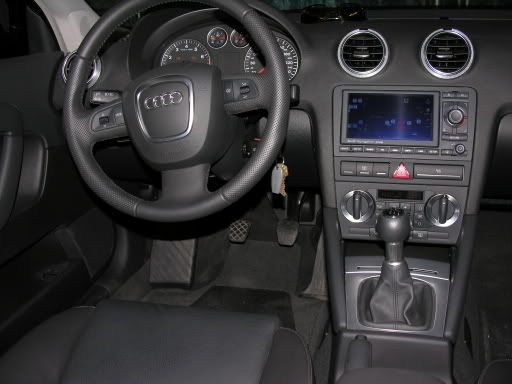

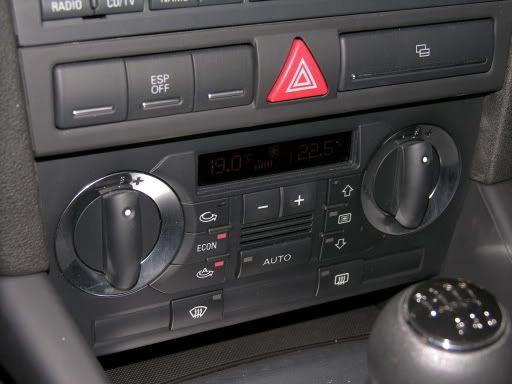
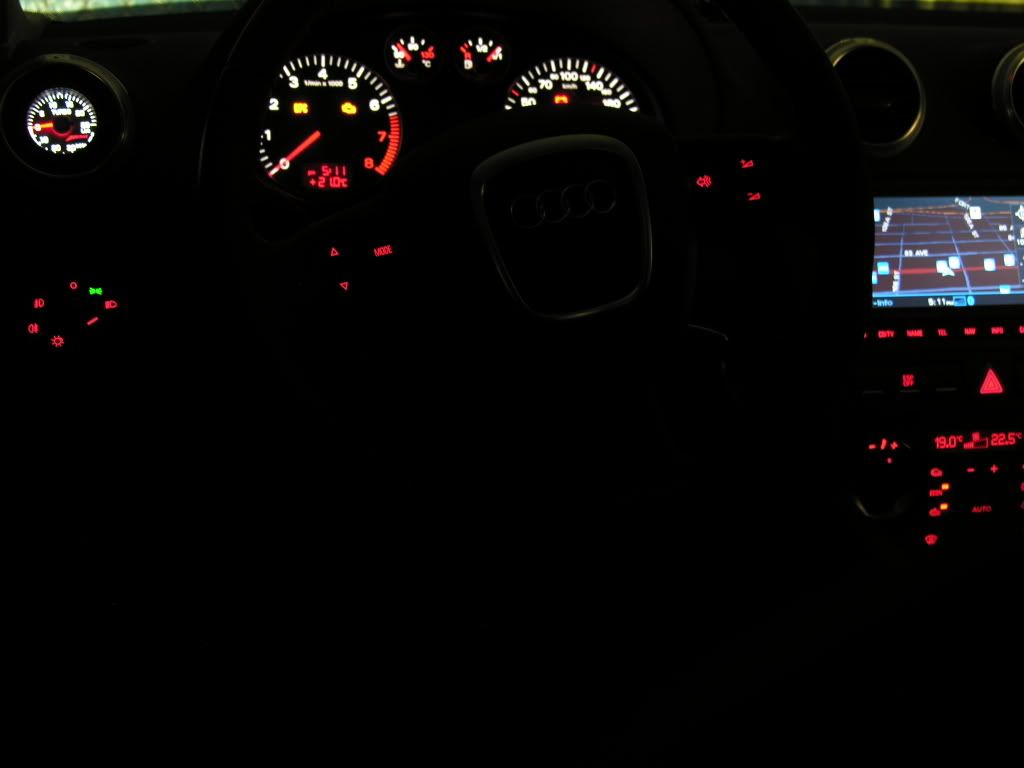
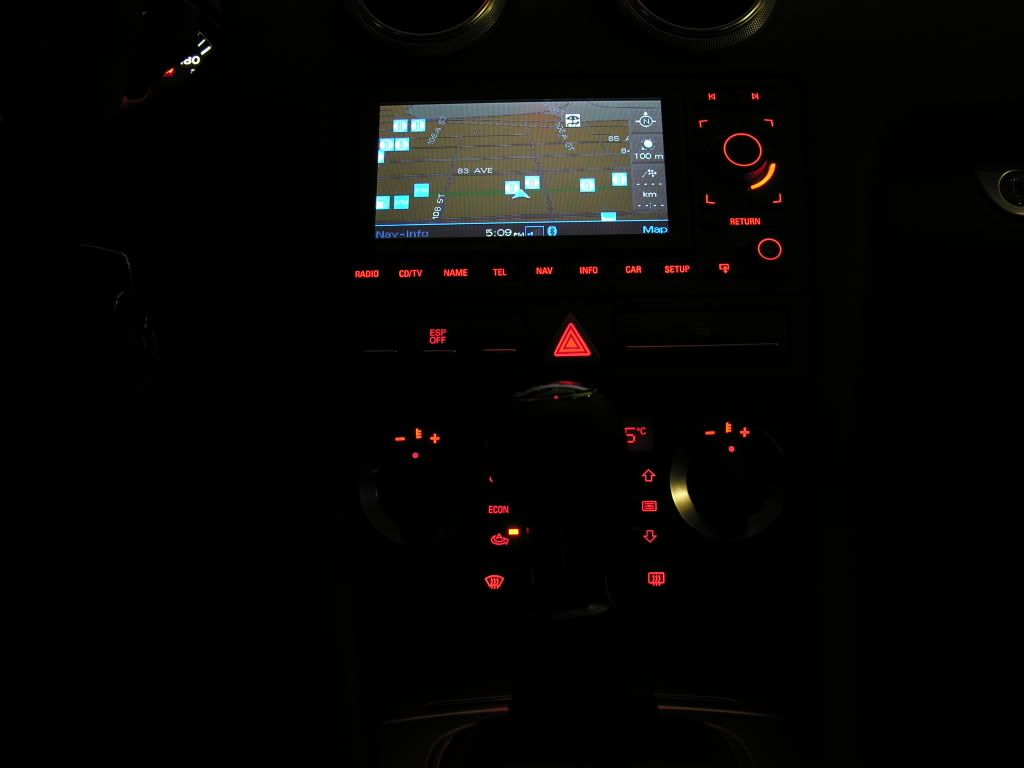
Oh, and whats this? Engineering Mode... very cool, if youre into a little bit more technical info: Location, Altitude, Road Speed... 
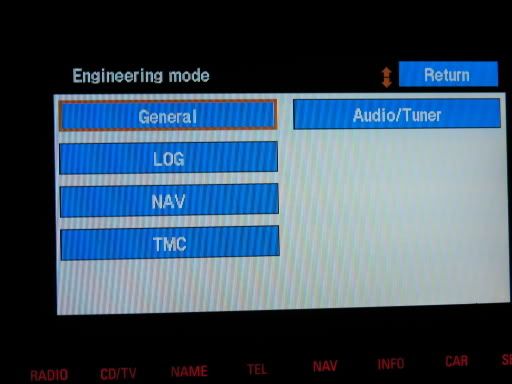
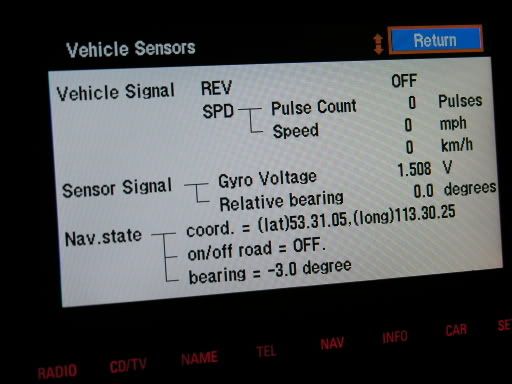
EDITED TO INCLUDE PART NUMBERS FOR
1) Double-DIN Passenger Airbag Warning Light - for US A3s
2) Double-DIN TPMS Switch